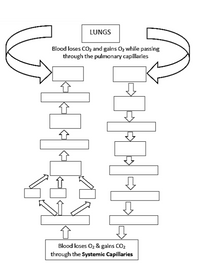
Human Anatomy & Physiology (11th Edition)
11th Edition
ISBN: 9780134580999
Author: Elaine N. Marieb, Katja N. Hoehn
Publisher: PEARSON
expand_more
expand_more
format_list_bulleted
Question
thumb_up100%
Pathway of blood through the Human Circulatory System
Trace the pathway of blood through the circulatory system by placing the parts found on the word box to the appropriate box where it belongs in the diagram.
A. Bicuspid Valve
B. Aortic Semilunar Valve
C. Pulmonary Semilunar Valve
D. Tricuspid Valve
E. Veins (from venules)
F. Artery (to arterioles)
G. Aorta
H. Pulmonary Artery
I. Pulmonary Vein
J. Superior Vena Cava
K. Inferior Vena Cava
L. Veinlet
M. Right Atrium
N. left Atrium
O. Right Ventricle
P. Left Ventricle
Q. Coronary Sinus

Transcribed Image Text:LUNGS
Blood loses COz and gains Oz while passing
through the pulmonary capillaries
Blood loses O2 & gains CO2
through the Systemic Capillaries
Expert Solution
This question has been solved!
Explore an expertly crafted, step-by-step solution for a thorough understanding of key concepts.
This is a popular solution
Trending nowThis is a popular solution!
Step by stepSolved in 2 steps with 1 images

Knowledge Booster
Learn more about
Need a deep-dive on the concept behind this application? Look no further. Learn more about this topic, biology and related others by exploring similar questions and additional content below.Similar questions
- Which of the following is true of the EKG? A. Depolarization of the atria cannot be seen on the EKG B. Repolarization of the atria cannot be seen on the EKG. C. Depolorization of the ventricles cannot be seen on the EKG. D. Repolorazition of the ventricles cannot be seen on the EKG.arrow_forwardWhy does the right ventricle have a bicuspid valve? a. The low pressure generated by the right ventricle is best suited to bicuspid valve compared with a tricuspid valve b. The high pressure generated by the right ventricle would be better controlled by a bicuspid compared with a tricuspid valve c. Only a short pumping distance to the lungs is required for the bicuspid valve d. The right ventricle does not have a bicuspid valvearrow_forwardRight and Left Ventricular pressures differ during: A. the entire cardiac cycle B. diastole C. systole D. the period of filling E. None of the above is correct.arrow_forward
- The peripheral chemoreceptors that respond to oxygen levels of the blood and regulate heart activity are located in Select one: a. structures near the carotids and aortic arch. b. the infundibulum of the hypothalamus. c. the left ventricle. d. the right ventricle. e. the medulla oblongata.arrow_forwardWhich of the following is not a type of capillary?a. continuousb. sinusoidc. elasticd. fenestratedarrow_forwardWhich statement about atrial contraction is true. A the end diastolic volume is the volume of blood that enters the ventricles during atrial contraction B the end diastolic volume is the volume of blood in the atria at the end of diastole C most of the filling of the ventricles occurs during atrial contraction D when atrial contraction begins the ventricles are already about 80% fullarrow_forward
- Atrial flutter is characterized by A. An atrial rate slower than the ventricular rate B. Waves with a saw tooth or picket fence pattern C. An atrial rate between 160 and 220 beats per minute D. All of the abovearrow_forwardWhat are some observations comparing the schematics of the fish and mammal circulatory systems? (Note: these are simplified schematics that don't show every single route for blood, so focus on the heart and the immediate inflow/outflow around the heart.)arrow_forwardfor its oxygen then it may die, forming rct. The severity of this condition depends on the precise location of the occlusion, which downstream tissues are involved, and how large an area of tissue dies. Use Figure 4.9 as a reference and list the flow of blood through both circuits in order, beginnng with the right atrium (don't forget to include the heart valves). 1. If an embolus breaks off in a systemic vein in the leg, it would be able to pass through: It would occlude: 2. If an embolus formed in the left ventricle, it would be able to pass through: 3. It would occlude: 4.arrow_forward
arrow_back_ios
arrow_forward_ios
Recommended textbooks for you
 Human Anatomy & Physiology (11th Edition)BiologyISBN:9780134580999Author:Elaine N. Marieb, Katja N. HoehnPublisher:PEARSON
Human Anatomy & Physiology (11th Edition)BiologyISBN:9780134580999Author:Elaine N. Marieb, Katja N. HoehnPublisher:PEARSON Biology 2eBiologyISBN:9781947172517Author:Matthew Douglas, Jung Choi, Mary Ann ClarkPublisher:OpenStax
Biology 2eBiologyISBN:9781947172517Author:Matthew Douglas, Jung Choi, Mary Ann ClarkPublisher:OpenStax Anatomy & PhysiologyBiologyISBN:9781259398629Author:McKinley, Michael P., O'loughlin, Valerie Dean, Bidle, Theresa StouterPublisher:Mcgraw Hill Education,
Anatomy & PhysiologyBiologyISBN:9781259398629Author:McKinley, Michael P., O'loughlin, Valerie Dean, Bidle, Theresa StouterPublisher:Mcgraw Hill Education, Molecular Biology of the Cell (Sixth Edition)BiologyISBN:9780815344322Author:Bruce Alberts, Alexander D. Johnson, Julian Lewis, David Morgan, Martin Raff, Keith Roberts, Peter WalterPublisher:W. W. Norton & Company
Molecular Biology of the Cell (Sixth Edition)BiologyISBN:9780815344322Author:Bruce Alberts, Alexander D. Johnson, Julian Lewis, David Morgan, Martin Raff, Keith Roberts, Peter WalterPublisher:W. W. Norton & Company Laboratory Manual For Human Anatomy & PhysiologyBiologyISBN:9781260159363Author:Martin, Terry R., Prentice-craver, CynthiaPublisher:McGraw-Hill Publishing Co.
Laboratory Manual For Human Anatomy & PhysiologyBiologyISBN:9781260159363Author:Martin, Terry R., Prentice-craver, CynthiaPublisher:McGraw-Hill Publishing Co. Inquiry Into Life (16th Edition)BiologyISBN:9781260231700Author:Sylvia S. Mader, Michael WindelspechtPublisher:McGraw Hill Education
Inquiry Into Life (16th Edition)BiologyISBN:9781260231700Author:Sylvia S. Mader, Michael WindelspechtPublisher:McGraw Hill Education

Human Anatomy & Physiology (11th Edition)
Biology
ISBN:9780134580999
Author:Elaine N. Marieb, Katja N. Hoehn
Publisher:PEARSON

Biology 2e
Biology
ISBN:9781947172517
Author:Matthew Douglas, Jung Choi, Mary Ann Clark
Publisher:OpenStax

Anatomy & Physiology
Biology
ISBN:9781259398629
Author:McKinley, Michael P., O'loughlin, Valerie Dean, Bidle, Theresa Stouter
Publisher:Mcgraw Hill Education,

Molecular Biology of the Cell (Sixth Edition)
Biology
ISBN:9780815344322
Author:Bruce Alberts, Alexander D. Johnson, Julian Lewis, David Morgan, Martin Raff, Keith Roberts, Peter Walter
Publisher:W. W. Norton & Company

Laboratory Manual For Human Anatomy & Physiology
Biology
ISBN:9781260159363
Author:Martin, Terry R., Prentice-craver, Cynthia
Publisher:McGraw-Hill Publishing Co.

Inquiry Into Life (16th Edition)
Biology
ISBN:9781260231700
Author:Sylvia S. Mader, Michael Windelspecht
Publisher:McGraw Hill Education